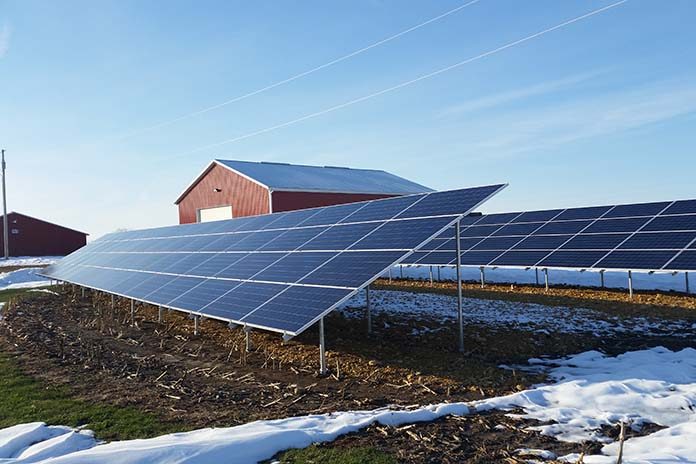
Solar energy radiation means revenues – at least for farmers who have successfully harnessed renewable energies. However, with the latest amendment to the Renewable Energy Act, the German Government has created new challenges for farms that want to build up a second line of business.
There are now only guaranteed grid feed-in rates for solar power from small photovoltaic installations. The larger systems are no longer included in the subsidy system. The paradigm shift throws up many questions. EnergyDecentral – the International Trade Fair for innovative energy supply to be held together with EuroTier in Hanover from 13 to 16 November 2018 – will supply the answers. The focus will be on technologies such as solar energy that allow farmers to use their own farm-produced electricity.
How much a photovoltaic system installed ready to use may cost depends on two factors – the electricity yield and the return on investment. As regards the latter aspect, the profitability of solar systems is currently undergoing a fundamental change. The amendment to the Renewable Energy Act (EEG) that entered into force at the beginning of 2017 limits the state-fixed grid feed-in tariffs to photovoltaic systems below 750 kilowatt peak. For all other installations – regardless of whether they are installed on housing, non-residential buildings or outdoor spaces – the fixed remuneration will be replaced by a tendering procedure. As on average an area of ten square metres is necessary per kilowatt peak, a large number of the roof-mounted systems on agricultural buildings will probably not be affected. Consequently many small and medium-sized farms will not need to worry about the amendment. For them the familiar Renewable Energy Act with remuneration over 20 years will continue to apply.
From full grid infeed to self-supply
However, the attractiveness of on-farm consumption by contrast with grid feed-in is rising not only for farmers with large installations. The use of solar electricity for lighting, powering motors in feeding systems or fans is already daily routine on small and medium-sized farms as well. Intelligent load management ensures perfect linking of the photovoltaic system and animal housing technology. As the solar system on the roof does not always produce electricity when it is actually needed, for efficiency of supply the surplus energy needs to be stored so that it can be used as required. Storing electricity obtained from renewable energy sources is therefore one of the key technologies being shown at EnergyDecentral.
Long-term bunkering of solar power
Decreasing costs and ever more efficient battery storage systems mean that ever more farms can use the advantages of an electricity storage system. At present the market is still modest. Alongside conventional lead accumulators, options are now above all lithium-ion accumulators that optionally buffer the surplus electricity or feed it into the public grid. The first salt water accumulators are now available to farmers as a further alternative. As the market continues to grow, Redox flow batteries will probably become economically more attractive, as their capacity can be scaled independently of the electrical output.
If the output provided by battery and solar system alone is not sufficient, photovoltaic diesel hybrid systems supply the farm reliably with electricity. For this BD Power Systems, for example, installs two generators and an intelligent control unit in addition to the solar modules in a compact container next to the lithium-ion accumulators. This enables farmers to ensure a permanent energy supply for important animal housing functions and the milking robots – quite independently of public electricity grids.
Renewable energies in live demonstrations
A look ahead at EnergyDecentral makes it clear that photovoltaic systems with pure electricity grid feed-in are on the way out. Modern all-in systems already cover a large part of the electricity demand on farms today, fill storage systems or charge electric vehicles. At the Fairgrounds in Hanover from 13 to 16 November, visitors will be able to see how advanced decentralized energy supply is in farming and what challenges are connected with implementing the vision. The Technical Programme will be accompanied by a Live Show with a DLG presenter displaying an electric vehicle charging station, the necessary grid technology, right through to electrically powered vehicles and the connection to the farm working circuit.
Further information about EnergyDecentral 2018 is available from DLG. Contact: Marcus Vagt, tel.: +49/(0)69/24788-279 or email: m.vagt@dlg.org.

















